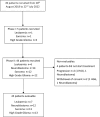PARC: a phase I/II study evaluating the safety and activity of pegylated recombinant human arginase BCT-100 in relapsed/refractory cancers of children and young adults
- PMID: 38357205
- PMCID: PMC10864630
- DOI: 10.3389/fonc.2024.1296576
PARC: a phase I/II study evaluating the safety and activity of pegylated recombinant human arginase BCT-100 in relapsed/refractory cancers of children and young adults
Abstract
Background: The survival for many children with relapsed/refractory cancers remains poor despite advances in therapies. Arginine metabolism plays a key role in the pathophysiology of a number of pediatric cancers. We report the first in child study of a recombinant human arginase, BCT-100, in children with relapsed/refractory hematological, solid or CNS cancers.
Procedure: PARC was a single arm, Phase I/II, international, open label study. BCT-100 was given intravenously over one hour at weekly intervals. The Phase I section utilized a modified 3 + 3 design where escalation/de-escalation was based on both the safety profile and the complete depletion of arginine (defined as adequate arginine depletion; AAD <8μM arginine in the blood after 4 doses of BCT-100). The Phase II section was designed to further evaluate the clinical activity of BCT-100 at the pediatric RP2D determined in the Phase I section, by recruitment of patients with pediatric cancers into 4 individual groups. A primary evaluation of response was conducted at eight weeks with patients continuing to receive treatment until disease progression or unacceptable toxicity.
Results: 49 children were recruited globally. The Phase I cohort of the trial established the Recommended Phase II Dose of 1600U/kg iv weekly in children, matching that of adults. BCT-100 was very well tolerated. No responses defined as a CR, CRi or PR were seen in any cohort within the defined 8 week primary evaluation period. However a number of these relapsed/refractory patients experienced prolonged radiological SD.
Conclusion: Arginine depletion is a clinically safe and achievable strategy in children with cancer. The RP2D of BCT-100 in children with relapsed/refractory cancers is established at 1600U/kg intravenously weekly and can lead to sustained disease stability in this hard to treat population.
Clinical trial registration: EudraCT, 2017-002762-44; ISRCTN, 21727048; and ClinicalTrials.gov, NCT03455140.
Keywords: arginase; arginine; cancer; pediatric; relapse.
Copyright © 2024 Fenwick, Weston, Wheatley, Hodgson, Marshall, Elliott, Makin, Ng, Brennan, Lowis, Adamski, Kilday, Cox, Gattens, Moore, Trahair, Ronghe, Campbell, Campbell, Williams, Kirby, Van Eijkelenburg, Keely, Scarpa, Stavrou, Fultang, Booth, Cheng, De Santo and Mussai.
Conflict of interest statement
The authors declare that the research was conducted in the absence of any commercial or financial relationships that could be construed as a potential conflict of interest.
Figures



References
Associated data
Grants and funding
LinkOut - more resources
Full Text Sources
Medical
Research Materials

